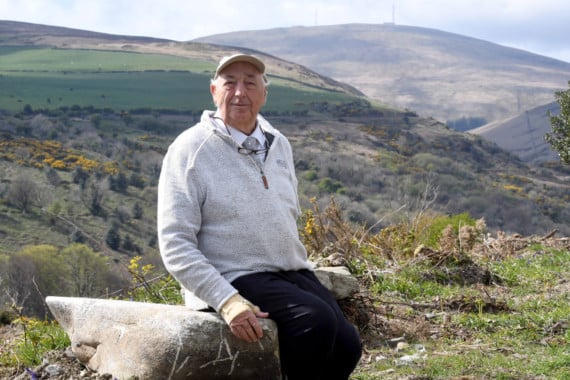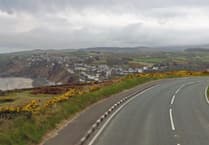A new 40-acre nature reserve in Laxey will soon be opening to the public.
Last year the Ballannette Trust acquired the land along the east of the Laxey River, behind the Salmon Centre and Ballacregga Corn Mill, which includes the site of the old Laxey tip.
Stewart Clague MBE, of the Ballannette Trust, said that though it was unplanned, buying this land by the Laxey River also involved acquiring three fields situated between there and Agneash, which had been ’four feet deep in gorse, briars and brambles’.
Originally, the land had been purchased to be able to control the water flow upriver of the Ballacregga Corn Mill, in the wake of the 2015 Laxey floods.
Mr Clague explained how the idea for the nature reserve came about.
’One Sunday when we walked up through the fields and we thought: "We’ll do something with this", we’ll make it into a nice area similar to what we have [at the Ballannette Trust nature reserve] in Baldrine.
’The views were absolutely immaculate.
’We could see from out to sea, up the valley, across to Dumbell’s Terrace, up Snaefell, around to North Barrule and we thought "this is fantastic".
’And we had no use for the land, so we thought "let’s put a bit back into society and let’s let everyone enjoy what we’re enjoying today".’
The fields, which had not been in use for years, are now to be used for a circular, fenced nature trail which leads uphill from the banks of the river, encompassing about two miles of newly-laid path which terminates at a gate and meets the road up to Agneash.
These dirt paths wind around open grassy areas which will be planted with wildflowers and bushes that will bloom in the summer, and be used for the grazing of sheep during the winter.
The Manx Independent previously reported the opposition of some Agneash residents to the works carried out to create these trails, with some residents arguing that nature and hedgerows were being damaged in the process.
Stewart pointed out that the work had been undertaken in consultation with the Department of the Environment, Food and Agriculture and UNESCO Biosphere Isle of Man, and offered any concerned residents a personal tour of the area to show them what has been done.
Boulders, originally washed down the river from the Snaefell mine, have also been placed to serve as seats where people can rest on the uphill sections of path, in addition at what is planned to be a picnic area.
From the elevated position of these fields, the views take in both Snaefell and Laxey bay.
The top of the trail looks onto an arrangement of thick stone walls, which Stewart believes may have been associated with the mine’s operations, possibly for gathering rainwater to turn the wheel.
From the trail people can follow a flight of landscaped earth stairs back down to the river bank, where a large area has been cleared and levelled, having previously been impassable and overgrown.
These areas will be covered in wood chippings and planted with wildflower seeds, with Stewart adding that these tend to grow better in rough conditions.
He hopes that the riverbanks will be a place for students to come to collect and learn about Manx wildflowers, which could be in bloom by summer.
Bluebells and grass can already be seen growing on the recently cleared area.
There will also be another, larger picnic area, which he said would be perfect for families or the activities of Cubs and Brownie groups.
Speaking about his hopes that this area would serve as a focal point for many future generations, Stewart said: ’It’s been done so that [the land] is left to a charity [the Ballannette Trust] so it can never be sold off.
’I’m not in it for profit. We’re in it for people to enjoy.’
He also mentioned possible plans to put in a bridge, joining these ’wildflower meadows’ with the river’s west bank.
Stewart explained: ’Hopefully people this summer will contribute and put wildflowers in and, along with shrubs and trees, we’ll make it into an absolutely smashing nature reserve, and then people can walk with their families and children, have a picnic and go up the side of the fields, enjoy the views and the seating and just sit there and think to themselves how lucky we are to live in the Isle of Man.’
At the site of the old tip, five old cars were pulled out and removed.
The site was littered with other debris, including old beer bottles dating back to the 50s and 60s, which Stewart remarked showed just how long the area had remained untouched.
There are plans to place a plaque here, to mark that the ’nature conversation area’ had been developed during the pandemic, so that future generations could look back on it as a reference point.
Stewart spoke about how he felt the Laxey valley was under-utilised, pointing out the lack of access to historical points of interest below the Laxey Wheel.
He said: ’I would like to see the entrance to the mines, and the washing and drying floors, all done up.
In another example, he thinks that there should also be a notice board pointing out the T-rocker junction [part of the wheel’s machinery].
He concluded: ’I’ve got to give government credit, they’ve started to invest in the valley and I want it to carry on.
’It’s got a future.’


.jpeg?width=209&height=140&crop=209:145,smart&quality=75)

.jpeg?width=209&height=140&crop=209:145,smart&quality=75)
Comments
This article has no comments yet. Be the first to leave a comment.